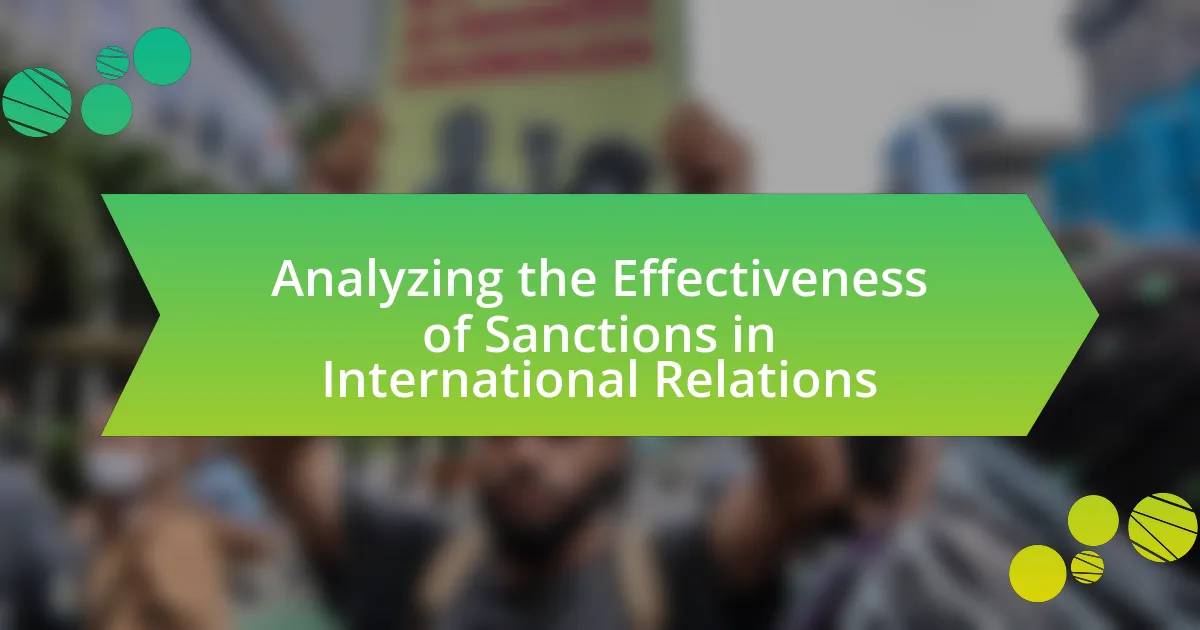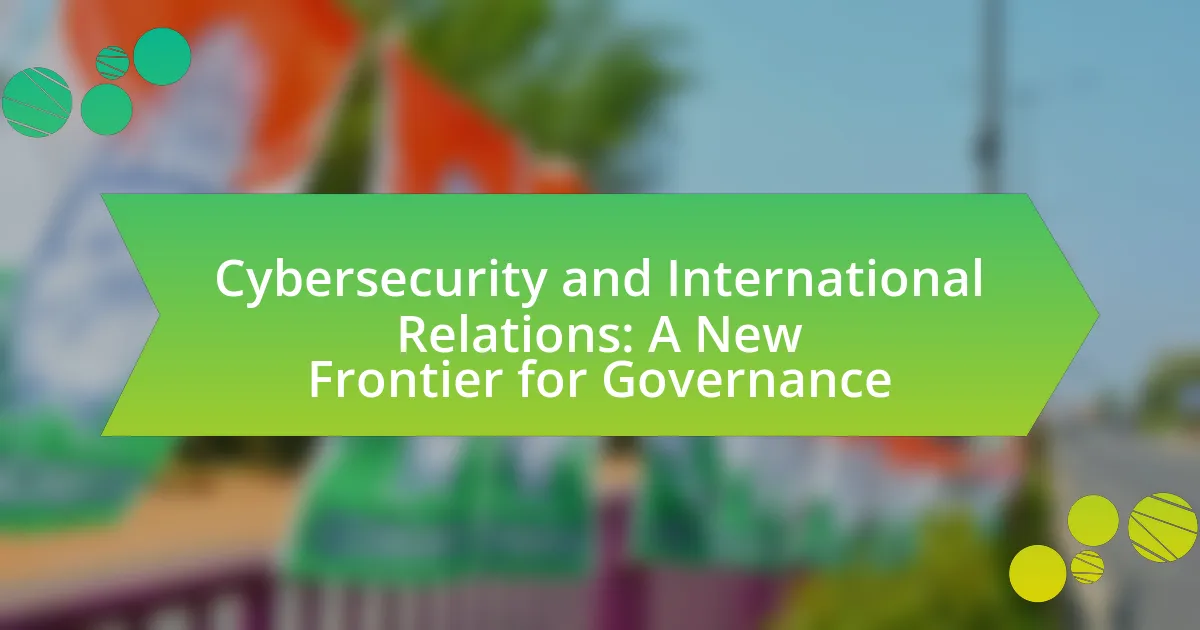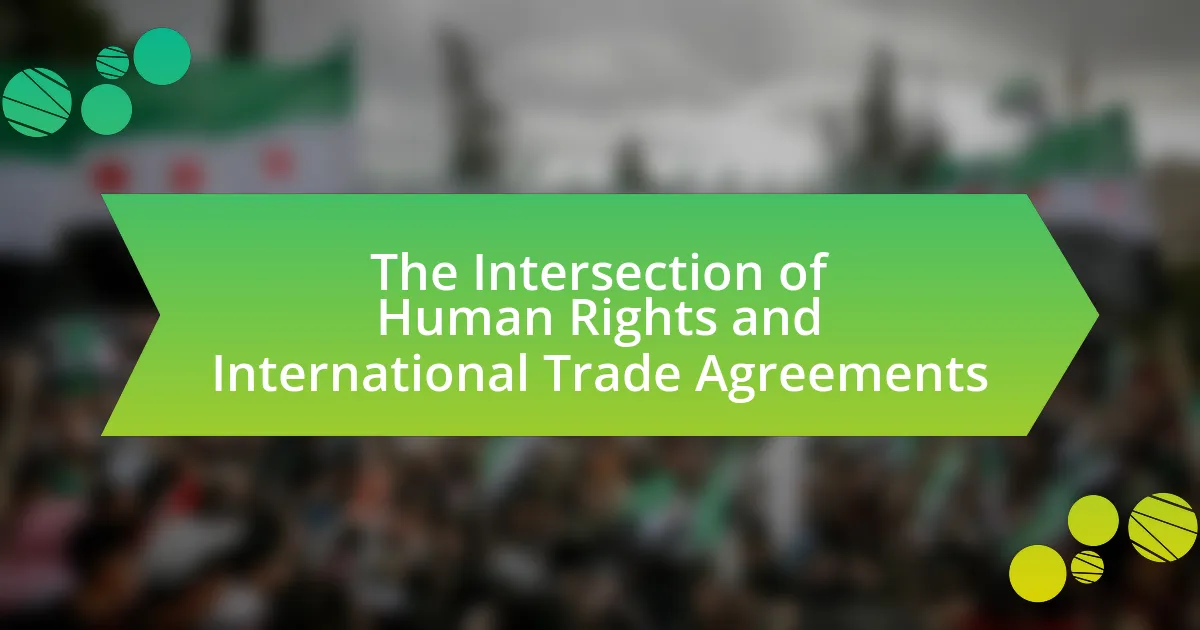The article examines the role of women in international diplomacy, highlighting their contributions to diverse perspectives, negotiation processes, and peacebuilding efforts. It traces the evolution of women’s participation in diplomacy, noting significant milestones and current statistics that reflect their increasing representation in diplomatic roles. The article also addresses the challenges women face, including gender bias, underrepresentation, and work-life balance issues, while discussing initiatives aimed at promoting gender equality in diplomacy. Notable success stories and practical steps for further supporting women in this field are also presented, emphasizing the importance of mentorship and supportive policies.
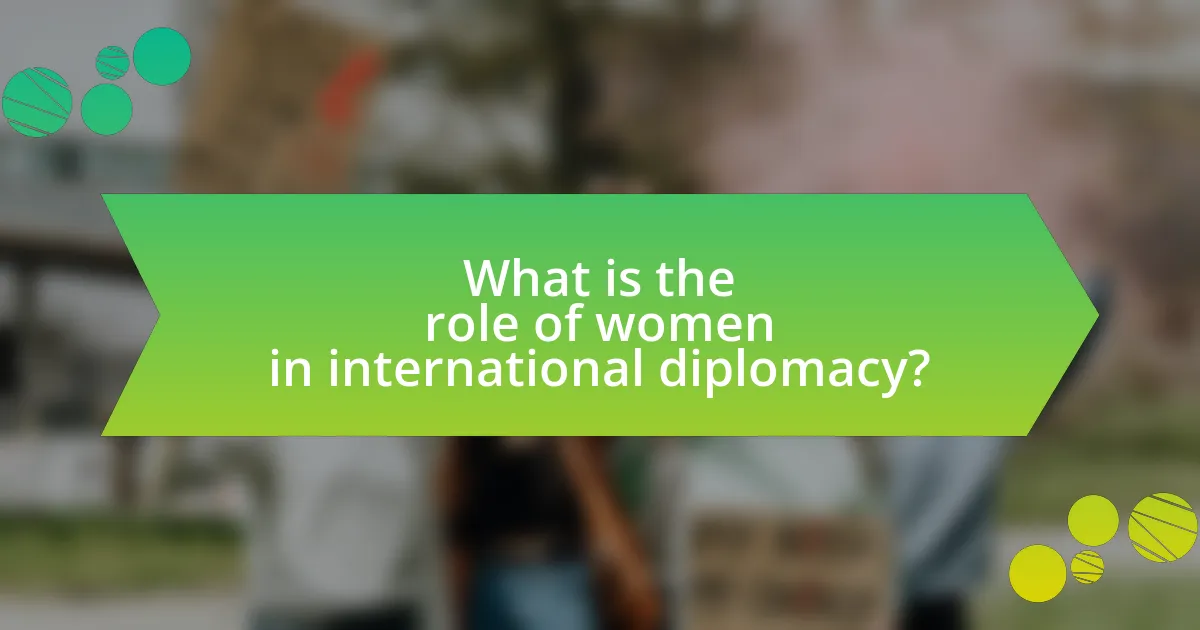
What is the role of women in international diplomacy?
Women play a crucial role in international diplomacy by contributing diverse perspectives, enhancing negotiation processes, and promoting peace and security. Their involvement has been shown to improve diplomatic outcomes, as evidenced by the United Nations Security Council Resolution 1325, which emphasizes the importance of women’s participation in peacebuilding and conflict resolution. Furthermore, research indicates that countries with higher representation of women in diplomatic roles tend to have more effective governance and stronger international relations. For instance, a study by the Council on Foreign Relations highlights that women’s leadership in diplomacy can lead to more comprehensive and sustainable solutions to global challenges.
How has the participation of women in diplomacy evolved over time?
The participation of women in diplomacy has significantly increased over time, particularly since the late 20th century. Historically, women were largely excluded from diplomatic roles, with only a few serving in such positions until the mid-1900s. The establishment of the United Nations in 1945 marked a turning point, as it encouraged member states to include women in their delegations. By the 1990s, the percentage of women in diplomatic roles began to rise more noticeably, with initiatives like the Beijing Declaration and Platform for Action in 1995 advocating for gender equality in all sectors, including diplomacy. As of 2021, women held approximately 30% of senior diplomatic positions globally, reflecting ongoing efforts to promote gender parity in international relations.
What historical milestones have marked women’s entry into diplomacy?
Women’s entry into diplomacy has been marked by several historical milestones, including the appointment of the first female ambassador, which occurred in 1949 when Eleanor Roosevelt was appointed as the U.S. delegate to the United Nations. This event symbolized a significant shift in the recognition of women’s roles in international relations. Another milestone was the establishment of the United Nations in 1945, which provided a platform for women to engage in global diplomacy. Additionally, the 1979 Convention on the Elimination of All Forms of Discrimination Against Women (CEDAW) further advanced women’s rights and participation in diplomatic processes. These milestones collectively illustrate the gradual but impactful integration of women into the field of diplomacy.
How have societal attitudes towards women in diplomacy changed?
Societal attitudes towards women in diplomacy have significantly evolved, shifting from skepticism and exclusion to greater acceptance and inclusion. Historically, women faced substantial barriers in diplomatic roles, often being relegated to support positions or entirely excluded from decision-making processes. However, recent decades have seen a marked increase in the representation of women in high-level diplomatic positions, with notable figures such as Angela Merkel and Hillary Clinton serving as prominent examples. According to the United Nations, as of 2021, women held 39% of senior leadership roles in UN peacekeeping operations, reflecting a growing recognition of women’s contributions to diplomacy. This change is further supported by initiatives aimed at promoting gender equality, such as the Women, Peace, and Security agenda established by UN Security Council Resolution 1325 in 2000, which emphasizes the importance of women’s participation in peace processes.
What are the current statistics on women in diplomatic positions?
As of 2023, women hold approximately 30% of diplomatic positions globally. This statistic reflects a gradual increase in female representation in diplomacy, with notable progress in various countries. For instance, the United Nations reports that women occupy around 40% of senior leadership roles in its diplomatic missions, indicating a positive trend towards gender parity in international relations. Additionally, research by the Council on Foreign Relations highlights that countries with higher female representation in diplomatic roles tend to have more inclusive foreign policies, further supporting the importance of women’s participation in diplomacy.
How do these statistics vary across different countries and regions?
Statistics regarding women’s representation in international diplomacy vary significantly across countries and regions. For instance, Nordic countries like Sweden and Norway have achieved gender parity in diplomatic positions, with women holding approximately 50% of ambassadorial roles. In contrast, regions such as the Middle East and North Africa exhibit lower representation, with women occupying only about 10-15% of diplomatic positions, as reported by the United Nations. Furthermore, countries like Rwanda stand out with over 60% of parliamentary seats held by women, influencing their diplomatic engagement positively. These disparities highlight the influence of cultural, political, and economic factors on women’s roles in diplomacy globally.
What roles do women typically occupy in diplomatic settings?
Women typically occupy roles such as ambassadors, diplomats, negotiators, and advisors in diplomatic settings. These positions allow women to influence international relations and policy-making. For instance, as of 2021, women held approximately 30% of ambassadorial positions globally, reflecting a gradual increase in representation. Additionally, women often serve in key roles within international organizations, such as the United Nations, where they contribute to peacekeeping and conflict resolution efforts. This trend indicates a growing recognition of the importance of gender diversity in diplomacy, enhancing the effectiveness of diplomatic missions.
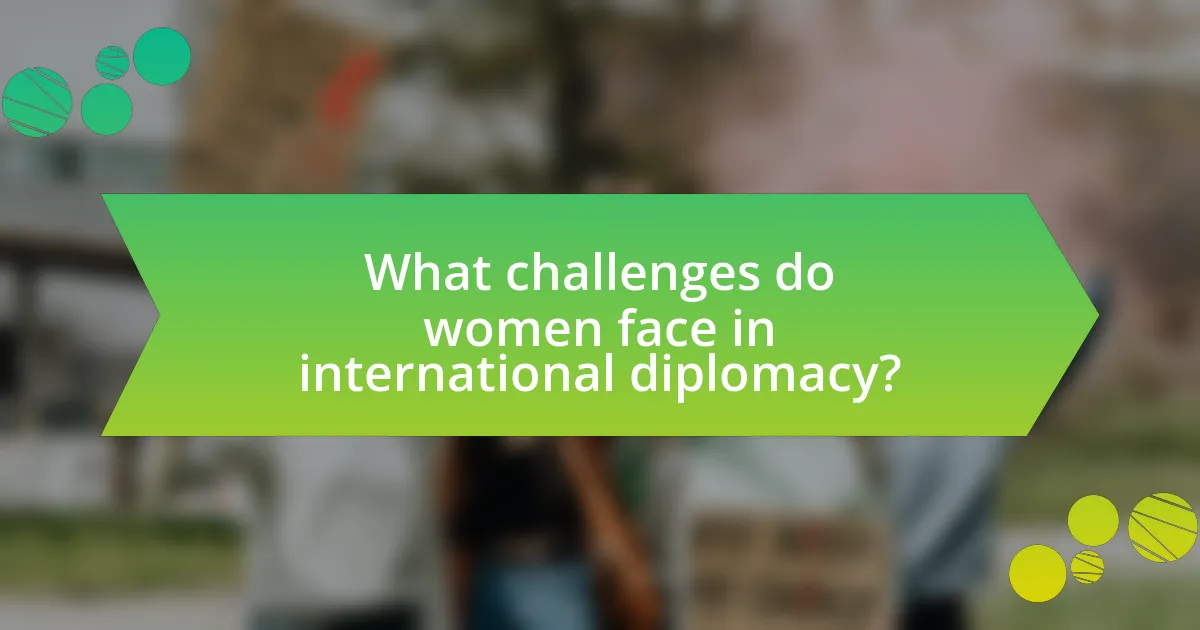
What challenges do women face in international diplomacy?
Women face significant challenges in international diplomacy, including gender bias, underrepresentation, and limited access to decision-making roles. Gender bias manifests in stereotypes that question women’s capabilities and authority, often leading to their contributions being undervalued. Underrepresentation is evident, as women hold only about 25% of senior diplomatic positions globally, which limits diverse perspectives in policy-making. Additionally, women often encounter barriers such as lack of mentorship and networking opportunities, which are crucial for career advancement in this field. These challenges hinder women’s effectiveness and influence in international diplomacy, as highlighted by the United Nations’ findings on gender parity in leadership roles.
What barriers hinder women’s advancement in diplomatic careers?
Barriers hindering women’s advancement in diplomatic careers include gender bias, lack of mentorship, and work-life balance challenges. Gender bias manifests in hiring practices and promotion opportunities, often favoring male candidates; a study by the United Nations indicates that women hold only 30% of senior leadership roles in international organizations. The absence of mentorship limits women’s professional development, as many women lack access to influential networks that can facilitate career growth. Additionally, the demanding nature of diplomatic work often conflicts with family responsibilities, making it difficult for women to balance both roles effectively. These factors collectively contribute to the underrepresentation of women in high-level diplomatic positions.
How do gender stereotypes impact women’s roles in diplomacy?
Gender stereotypes significantly limit women’s roles in diplomacy by perpetuating biases that associate leadership and negotiation skills predominantly with men. These stereotypes often lead to the underrepresentation of women in diplomatic positions, as decision-makers may unconsciously favor male candidates due to perceived notions of authority and competence. For instance, a study by the United Nations indicates that women hold only 24% of senior leadership roles in national governments, reflecting the impact of societal expectations on women’s professional advancement. Furthermore, women diplomats frequently face challenges such as being underestimated or having their contributions overlooked, which can hinder their effectiveness and influence in diplomatic negotiations.
What institutional obstacles exist for women in diplomatic positions?
Institutional obstacles for women in diplomatic positions include gender bias, lack of mentorship opportunities, and inadequate family support policies. Gender bias manifests in hiring and promotion practices, often favoring male candidates, which is evidenced by the underrepresentation of women in senior diplomatic roles; for instance, as of 2021, women held only 30% of ambassadorial positions globally. The absence of mentorship programs limits women’s professional development and networking opportunities, hindering their career advancement. Additionally, insufficient family support policies, such as inadequate parental leave and flexible working arrangements, disproportionately affect women, making it challenging for them to balance professional and personal responsibilities in the demanding field of diplomacy.
How do work-life balance issues affect women in diplomacy?
Work-life balance issues significantly hinder women’s advancement in diplomacy by creating barriers to career progression and job satisfaction. Women in diplomatic roles often face challenges in managing professional responsibilities alongside personal and family obligations, leading to increased stress and burnout. Research indicates that women diplomats report feeling pressured to choose between career advancement and family life, which can result in lower retention rates in high-level positions. For instance, a study by the United Nations indicated that women in diplomatic roles are underrepresented in senior positions, with only 30% of senior roles held by women, partly due to these work-life balance challenges. This imbalance not only affects individual careers but also limits the diversity and effectiveness of diplomatic teams.
What support systems are available for women managing work-life balance?
Support systems available for women managing work-life balance include flexible work arrangements, mentorship programs, and access to childcare services. Flexible work arrangements, such as remote work and adjustable hours, allow women to better integrate their professional and personal responsibilities. Mentorship programs provide guidance and support from experienced professionals, helping women navigate challenges in their careers. Access to childcare services is crucial, as it alleviates the burden of childcare responsibilities, enabling women to focus on their work. According to a report by McKinsey & Company, organizations that implement such support systems see improved retention rates and job satisfaction among women, highlighting the effectiveness of these measures in promoting work-life balance.
How do family responsibilities influence women’s career choices in diplomacy?
Family responsibilities significantly influence women’s career choices in diplomacy by often limiting their availability for demanding roles and travel. Women frequently face societal expectations to prioritize family care, which can lead to career interruptions or the selection of less demanding positions. Research indicates that women in diplomacy are more likely to choose roles that offer flexible hours or remote work options, as seen in a study by the United Nations, which found that 60% of female diplomats cited family obligations as a key factor in their career decisions. This dynamic can hinder women’s advancement in a field that traditionally values continuous presence and commitment.
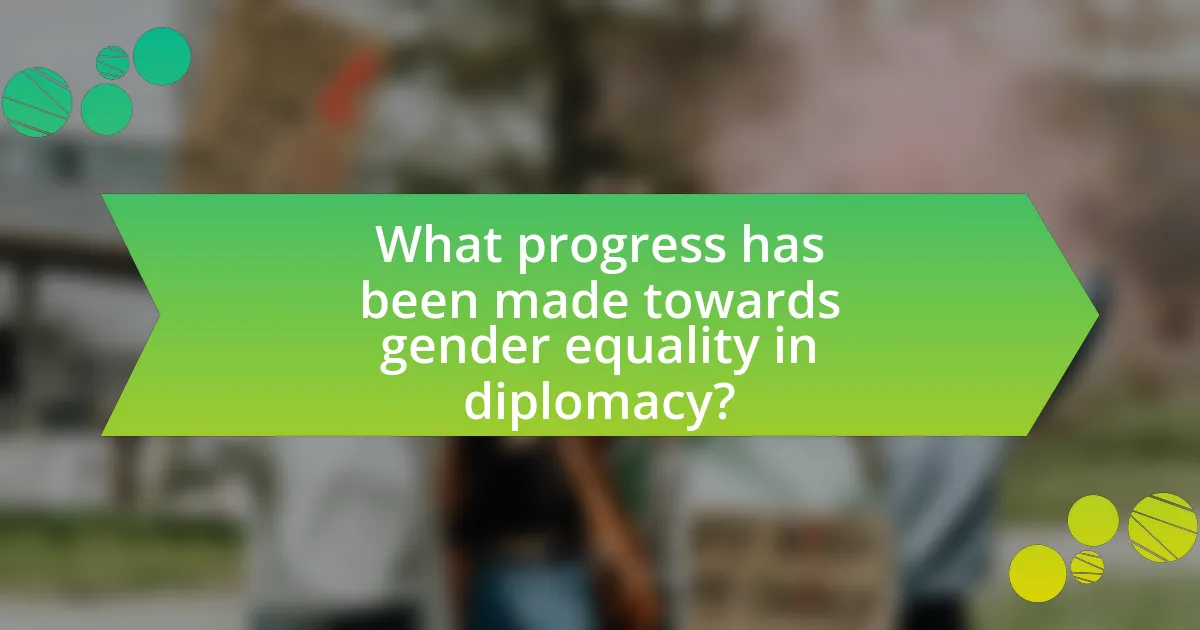
What progress has been made towards gender equality in diplomacy?
Significant progress has been made towards gender equality in diplomacy, evidenced by increased representation of women in high-level diplomatic positions. As of 2021, women held 38% of senior roles in foreign ministries across the globe, a notable rise from 27% in 2015, according to the United Nations. Additionally, initiatives such as the “Women, Peace and Security” agenda have been adopted by various countries, promoting women’s participation in peace negotiations and conflict resolution. Furthermore, organizations like the European Union and the United Nations have implemented policies aimed at achieving gender parity in diplomatic appointments, reinforcing the commitment to gender equality in international relations.
What initiatives have been implemented to promote women in diplomacy?
Various initiatives have been implemented to promote women in diplomacy, including the establishment of mentorship programs, gender parity commitments, and international networks. For instance, the United Nations has launched the “Women, Peace and Security” agenda, which emphasizes women’s participation in peace processes and decision-making roles. Additionally, organizations like the European Union have set targets for gender balance in diplomatic positions, aiming for at least 40% representation of women in leadership roles by 2024. These initiatives are supported by research indicating that increased female representation in diplomacy leads to more effective conflict resolution and peacebuilding outcomes.
How effective have these initiatives been in increasing women’s representation?
The initiatives aimed at increasing women’s representation in international diplomacy have shown significant effectiveness, with women’s participation rising from 19% in 2010 to approximately 30% in 2021 within various diplomatic roles. This increase is attributed to targeted policies such as gender quotas and mentorship programs, which have been implemented by organizations like the United Nations and various governments. For instance, the UN’s Gender Parity Strategy has set specific targets for women’s representation, leading to measurable progress in leadership positions.
What role do international organizations play in supporting women in diplomacy?
International organizations play a crucial role in supporting women in diplomacy by promoting gender equality, providing training, and facilitating networking opportunities. For instance, the United Nations has established initiatives like UN Women, which focuses on empowering women in leadership roles, including diplomatic positions. Additionally, organizations such as the European Union and the Organization for Security and Co-operation in Europe implement policies and programs aimed at increasing women’s representation in diplomatic missions. These efforts are backed by data indicating that countries with higher female representation in diplomacy tend to have more effective and inclusive foreign policies, as highlighted in various studies conducted by the World Economic Forum.
What success stories highlight women’s achievements in international diplomacy?
Women have made significant strides in international diplomacy, with notable success stories including the appointment of Ellen Johnson Sirleaf as Liberia’s first female president and the first elected female head of state in Africa, who played a crucial role in post-conflict reconstruction and peacebuilding. Another prominent figure is Angela Merkel, who served as Chancellor of Germany and was instrumental in shaping European Union policies, particularly during the Eurozone crisis. Additionally, former U.S. Secretary of State Hillary Clinton’s advocacy for women’s rights on a global scale during her tenure exemplifies women’s influence in international relations. These achievements underscore the growing impact of women in diplomacy, contributing to peace, security, and development on a global level.
Who are some notable female diplomats and their contributions?
Notable female diplomats include Madeleine Albright, Condoleezza Rice, and Hillary Clinton, each making significant contributions to international relations. Madeleine Albright served as the first female U.S. Secretary of State from 1997 to 2001, advocating for NATO expansion and promoting democracy in Eastern Europe. Condoleezza Rice, also a U.S. Secretary of State from 2005 to 2009, played a crucial role in shaping U.S. foreign policy during the Iraq War and emphasized the importance of democracy in the Middle East. Hillary Clinton, serving as Secretary of State from 2009 to 2013, focused on a “smart power” approach, balancing diplomacy and development with defense, and was instrumental in the U.S. response to the Arab Spring and the military intervention in Libya. These women have not only broken barriers in diplomacy but have also influenced global policies and international relations significantly.
What lessons can be learned from successful women in diplomacy?
Successful women in diplomacy demonstrate the importance of resilience, strategic communication, and collaboration. Resilience allows them to navigate challenges and setbacks, as seen in the careers of figures like Madeleine Albright, who overcame significant obstacles to become the first female U.S. Secretary of State. Strategic communication is crucial, as effective negotiation often hinges on the ability to articulate positions clearly and persuasively, a skill exemplified by women like Condoleezza Rice, who effectively communicated U.S. foreign policy. Collaboration is essential in diplomacy, as successful women often build coalitions and foster partnerships, illustrated by the work of women such as Helen Clark, who emphasized multilateral cooperation during her tenure as Administrator of the United Nations Development Programme. These lessons highlight the critical skills and attributes that contribute to success in the field of diplomacy.
What practical steps can be taken to further support women in diplomacy?
To further support women in diplomacy, implementing mentorship programs specifically designed for women can significantly enhance their career development. These programs can connect experienced female diplomats with emerging leaders, providing guidance, networking opportunities, and skill development. Research indicates that mentorship increases retention rates and career advancement for women in various fields, including diplomacy. Additionally, establishing policies that promote work-life balance, such as flexible working hours and parental leave, can create a more inclusive environment. According to the United Nations, countries with supportive family policies see higher participation rates of women in leadership roles. Furthermore, increasing visibility of female diplomats through media representation and public speaking engagements can inspire future generations and challenge stereotypes.
How can mentorship programs enhance women’s careers in diplomacy?
Mentorship programs can significantly enhance women’s careers in diplomacy by providing guidance, networking opportunities, and skill development. These programs connect aspiring female diplomats with experienced mentors who can share insights about navigating the complexities of international relations and diplomacy. Research indicates that women with mentors are more likely to advance in their careers, as they receive tailored advice and support that addresses the unique challenges they face in a male-dominated field. For instance, a study by the United Nations Development Programme found that mentorship initiatives led to a 30% increase in women’s participation in leadership roles within diplomatic missions. This evidence underscores the critical role mentorship plays in empowering women and fostering their professional growth in diplomacy.
What policies can governments adopt to promote gender equality in diplomatic roles?
Governments can adopt policies such as implementing gender quotas, providing mentorship programs, and ensuring equal pay to promote gender equality in diplomatic roles. Gender quotas can increase women’s representation in diplomatic positions, as seen in countries like Rwanda, where women hold over 60% of parliamentary seats due to such policies. Mentorship programs can support women’s career advancement by connecting them with experienced diplomats, fostering a more inclusive environment. Additionally, ensuring equal pay for equal work addresses wage disparities that often discourage women from pursuing diplomatic careers, as highlighted by the World Economic Forum’s Global Gender Gap Report, which indicates that closing the gender pay gap can significantly enhance women’s participation in various sectors, including diplomacy.



